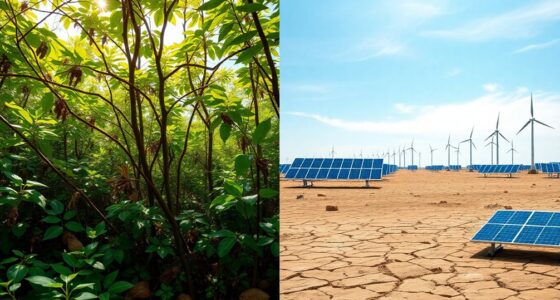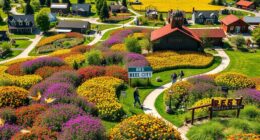Indigenous guardians lead community conservation by blending traditional knowledge, cultural practices, and sustainable land management to protect ecosystems and build resilience. Their strong connection to land guides responsible stewardship, ensuring ecosystems are preserved for future generations. These efforts foster partnerships with outside organizations and promote local leadership. As you explore further, you’ll discover how their unique approaches can inspire broader environmental solutions rooted in respect, community, and cultural pride.
Key Takeaways
- Indigenous guardians leverage traditional ecological knowledge to lead effective community-based conservation initiatives.
- Their leadership fosters sustainable resource management aligned with cultural values and ecosystem health.
- Community-led conservation efforts empower indigenous groups, ensuring long-term environmental and cultural preservation.
- Partnerships with governments and organizations enhance indigenous stewardship and expand conservation impact.
- Recognizing indigenous guardians’ roles promotes cultural pride and strengthens resilience in environmental management.

Have you ever wondered how communities can play a pivotal role in protecting their environment? It turns out, indigenous stewardship is one of the most powerful ways communities contribute to conservation. Indigenous peoples have a deep-rooted connection to their land, built over generations of living in harmony with nature. This long-standing relationship isn’t just about resource use; it’s about responsibility, respect, and ensuring that ecosystems thrive for future generations. When indigenous communities lead conservation efforts, they often do so with a profound understanding of local ecosystems, traditional practices, and sustainable resource management. Their stewardship isn’t just about protecting land; it’s about safeguarding cultural identity and heritage that are intertwined with the environment.
Cultural preservation plays a essential role in community conservation. Many indigenous practices are rooted in traditions that emphasize coexistence with nature rather than exploitation. These traditions often include sacred sites, traditional hunting and fishing methods, and sacred rituals that reinforce the importance of maintaining ecological balance. By actively preserving their cultural heritage, indigenous communities reinforce their commitment to environmental health. This cultural preservation isn’t static—it evolves with new challenges, blending traditional knowledge with modern conservation strategies. Supporting traditional ecological knowledge can lead to more effective and culturally respectful conservation outcomes. This approach not only benefits the environment but also strengthens cultural identity, fostering resilience and pride. Additionally, integrating Cultural Intelligence into conservation efforts can enhance collaboration between indigenous communities and external organizations, ensuring respectful and effective partnerships. Recognizing the value of indigenous land management practices has proven to improve the sustainability of conservation projects worldwide. Moreover, the integration of indigenous governance models often results in more adaptive and resilient conservation strategies that are responsive to local needs. Incorporating community-led decision-making further empowers indigenous groups and promotes sustainable resource use.
In many cases, indigenous-led conservation initiatives serve as models for broader environmental efforts. Governments and organizations are increasingly recognizing the value of indigenous stewardship, partnering with local communities to implement protected areas and sustainable management plans. These collaborations often lead to better outcomes because they are rooted in local knowledge and respect for cultural traditions. When you support indigenous stewardship, you’re supporting a way of life that prioritizes harmony with nature, cultural integrity, and long-term sustainability. It’s a reminder that effective conservation isn’t just about setting aside land; it’s about empowering communities to take ownership of their environment and cultural heritage.
Ultimately, community conservation driven by indigenous guardians highlights the importance of respecting traditional knowledge and cultural preservation. It demonstrates that sustainable environmental management is most effective when communities are at the forefront, leading with their unique perspectives, skills, and deep connection to their land. By embracing indigenous stewardship, we acknowledge that protecting the environment isn’t just a modern effort—it’s a continuation of centuries-old traditions rooted in respect, responsibility, and cultural pride.
Frequently Asked Questions
How Do Indigenous Guardians Fund Their Conservation Efforts?
You might wonder how Indigenous Guardians fund their conservation efforts. They use diverse funding strategies, including government grants, donations, and grants from environmental organizations. Community partnerships also play a crucial role, as they help secure resources and support. By collaborating with local communities, NGOs, and government agencies, Guardians guarantee sustainable funding and shared responsibility, empowering them to protect their lands effectively and maintain long-term conservation initiatives.
What Challenges Do Indigenous Guardians Face in Community Conservation?
Ever wonder what hurdles indigenous guardians face in protecting their lands? You might be surprised to learn they often struggle with limited resources and bureaucratic barriers that threaten cultural preservation. Their work relies heavily on community engagement, yet external pressures like commercial interests and climate change can undermine these efforts. These challenges test their resilience and dedication, highlighting the urgent need for broader support to sustain their crucial conservation work.
How Can Non-Indigenous Communities Support Indigenous Conservation Initiatives?
You can support indigenous conservation initiatives by respecting and valuing their cultural preservation and traditional knowledge. Listen actively to their needs and priorities, providing resources or platforms for their voices. Share information about their efforts to raise awareness and foster understanding. Collaborate as allies, ensuring their leadership in decision-making processes. Your support helps safeguard their heritage and promotes sustainable conservation rooted in centuries of traditional wisdom.
Are There Legal Protections for Indigenous Guardian-Led Projects?
Imagine lush forests and vibrant waters protected by Indigenous Guardians. You should know that legal frameworks are increasingly recognizing these projects, offering some protections. Policy support is essential, but gaps remain. While laws can safeguard Indigenous-led initiatives, enforcement is key. Supporting advocacy for stronger legal protections helps guarantee these guardians preserve ecosystems and culture, empowering them to lead sustainable conservation efforts with confidence and respect.
How Do Indigenous Guardians Measure Success in Conservation?
You might wonder how indigenous guardians measure success in conservation. They often rely on traditional knowledge to track ecosystem health and species populations, ensuring sustainable practices. Success also means cultural preservation, maintaining their traditions and spiritual connections to the land. When these elements are thriving, it indicates effective conservation efforts. Ultimately, success is about balancing environmental health with cultural integrity, fostering resilient communities that protect their natural and cultural heritage.
Conclusion
By now, it’s clear that indigenous guardians play a crucial role in community conservation. Their deep connection to the land and cultural wisdom create sustainable solutions that benefit everyone. You might wonder, can we truly protect our environment without honoring these indigenous voices? Embracing their leadership not only preserves nature but also empowers communities. So, isn’t it time we recognize and support these guardians as essential stewards of our planet’s future?








